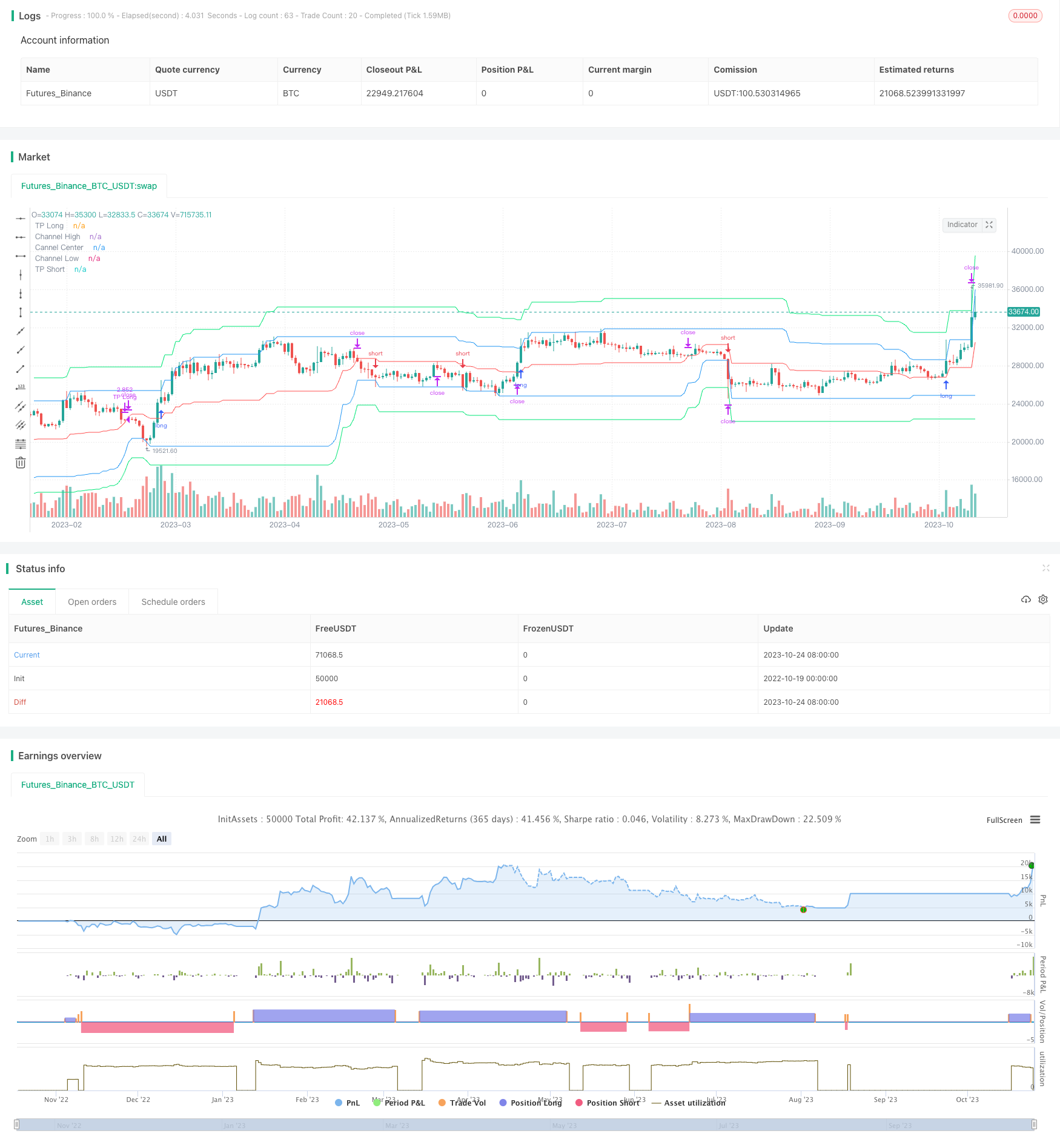
概述
该策略基于唐奇安(Donchian)通道指标实现自适应跟踪市场行情,进行趋势交易。当价格突破唐奇安通道时,进行趋势追踪;当价格回归通道内时,进行止损平仓。
策略原理
计算一定周期内的最高价和最低价,形成唐奇安通道。通道中线为期间最高价和最低价的平均值。
当价格突破通道上沿时,进行多头开仓;当价格突破通道下沿时,进行空头开仓。
开仓后,止损线追踪通道中线;止盈线追踪突破通道一定比例的价格。
当价格重新回到通道内时,进行止损平仓。
优势分析
该策略利用唐奇安通道判断趋势方向,能快速捕捉市场突破。
采用通道中线追踪止损,可以实现盈利的保护。
根据用户设置止盈幅度,适当放大盈利空间。
能够自适应不同行情环境,如盘整、突破、回调等,灵活调整仓位。
策略交易逻辑简单清晰,容易理解掌握。
风险分析
策略仅基于突破通道交易,对盘整市场无法有效应对。
存在突破假信号的风险,需要结合其他指标验证。
停止盈亏设置不当,可能导致过早止损或盈利不足。
通道周期设置不当,会影响交易信号的准确性。
仓位设置过大,会 amplify 市场波动对账户的影响。
机器人交易存在意外中断的风险,需要确保系统稳定可靠。
策略优化
结合交易量指标,避免追随虚假突破。
增加趋势指标判断,提高开仓信号的准确性。
优化止盈止损算法,实现动态调整。
根据市场环境实时调整仓位管理策略。
研究夜盘、盘前的数据,寻找更优入场时机。
测试不同周期Parameter,寻找最佳参数组合。
增加模型校验模块,避免过拟合。
总结
该策略整体来说是一个较为简单实用的自适应趋势策略。具有快速捕捉趋势突破,实现盈利保护等特点。同时也存在一些针对盘整行情无效,假突破带来亏损等缺点。未来的优化方向在于结合更多指标过滤信号,动态调整止盈止损策略,从而适应更多市场环境。
策略源码
/*backtest
start: 2022-10-19 00:00:00
end: 2023-10-25 00:00:00
period: 1d
basePeriod: 1h
exchanges: [{"eid":"Futures_Binance","currency":"BTC_USDT"}]
*/
//Noro
//2020
//@version=4
strategy(title = "Noro's Donchian Strategy", shorttitle = "Donchian str", overlay = true, default_qty_type = strategy.percent_of_equity, initial_capital = 100, default_qty_value = 100, commission_value = 0.1)
//Settings
needlong = input(true, defval = true, title = "Long")
needshort = input(true, defval = true, title = "Short")
tp = input(defval = 10, minval = 1, title = "Take profit")
lotsize = input(100, defval = 100, minval = 1, maxval = 10000, title = "Lot, %")
pclen = input(50, minval = 1, title = "Price Channel Length")
showll = input(true, defval = true, title = "Show lines")
showbg = input(false, defval = false, title = "Show Background")
showof = input(true, defval = true, title = "Show Offset")
fromyear = input(1900, defval = 1900, minval = 1900, maxval = 2100, title = "From Year")
toyear = input(2100, defval = 2100, minval = 1900, maxval = 2100, title = "To Year")
frommonth = input(01, defval = 01, minval = 01, maxval = 12, title = "From Month")
tomonth = input(12, defval = 12, minval = 01, maxval = 12, title = "To Month")
fromday = input(01, defval = 01, minval = 01, maxval = 31, title = "From day")
today = input(31, defval = 31, minval = 01, maxval = 31, title = "To day")
//Price Channel
h = highest(high, pclen)
l = lowest(low, pclen)
center = (h + l) / 2
tpl = h * (100 + tp) / 100
tps = l * (100 - tp) / 100
//Lines
tpcol = showll ? color.lime : na
pccol = showll ? color.blue : na
slcol = showll ? color.red : na
offset = showof ? 1 : 0
plot(tpl, offset = offset, color = tpcol, title = "TP Long")
plot(h, offset = offset, color = pccol, title = "Channel High")
plot(center, offset = offset, color = slcol, title = "Cannel Center")
plot(l, offset = offset, color = pccol, title = "Channel Low")
plot(tps, offset = offset, color = tpcol, title = "TP Short")
//Background
size = strategy.position_size
bgcol = showbg == false ? na : size > 0 ? color.lime : size < 0 ? color.red : na
bgcolor(bgcol, transp = 70)
//Trading
truetime = time > timestamp(fromyear, frommonth, fromday, 00, 00) and time < timestamp(toyear, tomonth, today, 23, 59)
lot = 0.0
lot := size != size[1] ? strategy.equity / close * lotsize / 100 : lot[1]
mo = 0
mo := strategy.position_size != 0 ? 0 : high >= center and low <= center ? 1 : mo[1]
if h > 0
strategy.entry("Long", strategy.long, lot, stop = h, when = strategy.position_size <= 0 and needlong and truetime and mo)
strategy.exit("TP Long", "Long", limit = tpl, stop = center)
strategy.entry("Short", strategy.short, lot, stop = l, when = strategy.position_size >= 0 and needshort and truetime and mo)
strategy.exit("TP Short", "Short", limit = tps, stop = center)
if time > timestamp(toyear, tomonth, today, 23, 59)
strategy.close_all()
strategy.cancel("Long")
strategy.cancel("Short")